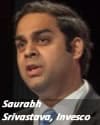Increasing evidence of the impact of trade implementation costs on fund performance is driving a revolution on buy-side trading desk, according to Saurabh Srivastava, global head of electronic trading, at US-headquartered global asset manager Invesco.
“Buy-side trading desks must adopt a more data-driven approach to decision-making,” he told delegates at TradeTech Europe 2014, noting also that modeling and quantifying the investment process must become a “core competence” of the trading desk in order to fully take advantage of the execution data now becoming available. “In the future, quants and data scientists will sit alongside traders,” he added.
For Invesco, which manages US$790 billion in assets for clients in 150 countries, and employs more than 50 staff on its trading desks globally, there is now a greater awareness of the role of trading costs in the performance of funds and ultimately returns to investors, said Srivastava. “Effective implementation not only reduces trading costs, but also helps to increase fund capacity and facilitate higher turnover, creating greater scope for use of more investment ideas and strategies,” he explained.
This appreciation of the importance of trading to the value delivered to the end-investor has led Invesco to make a strategic investment in the capabilities of its trading desk, including the hiring of additional staff, the implementation of a new global execution management system (EMS) and the ability to develop proprietary algorithms.
According to Srivastava, efforts by the buy-side to improve execution performance have been hampered by a lack of “credible” measurements of execution performance and a “dearth” of well-defined processes, both pre-requisites for optimisation of trading. “It is still a challenge for the buy-side to leverage the power of transaction cost analysis,” he said. “What has been missing is conclusive quantitative evidence of the beneficial impact of improvements.”
Invesco recently hired two quant-based PhDs to increase the firm’s data analysis capabilities and has also invested in technology, not restricted to the new EMS. Noting that the firm had already generated execution improvements and rewarded high-performing brokers, Srivastava said the growing appreciation of trading’s impact on investment outcomes was leading to a more proactive approach to ownership of technology. He added that Invesco had recently hired to align its in-house IT skills with the evolving needs of its trading desk.
The firm has also hired a developer from a high-frequency trading outfit as part of its initiative to develop its own proprietary execution algorithms. Although some hedge funds have designed their own algos, proprietary algorithms are almost unheard of among long-only asset managers. Srivastava said the decision was taken to help the trading desk to take greater control of over how its orders are executed. “Electronic trading is a crucial part of the investment process,” he observed, adding that proprietary algorithms would better align trading with the investment objectives of the end-investor.
Srivastava said that the changes to Invesco’s trading desk had led to a rationalisation of its use of sell-side resources and an increase in the exchange of constructive ideas for improvement of the firm’s trading performance. Invesco is also benchmarking the performance of its own algos against that of its brokers.
